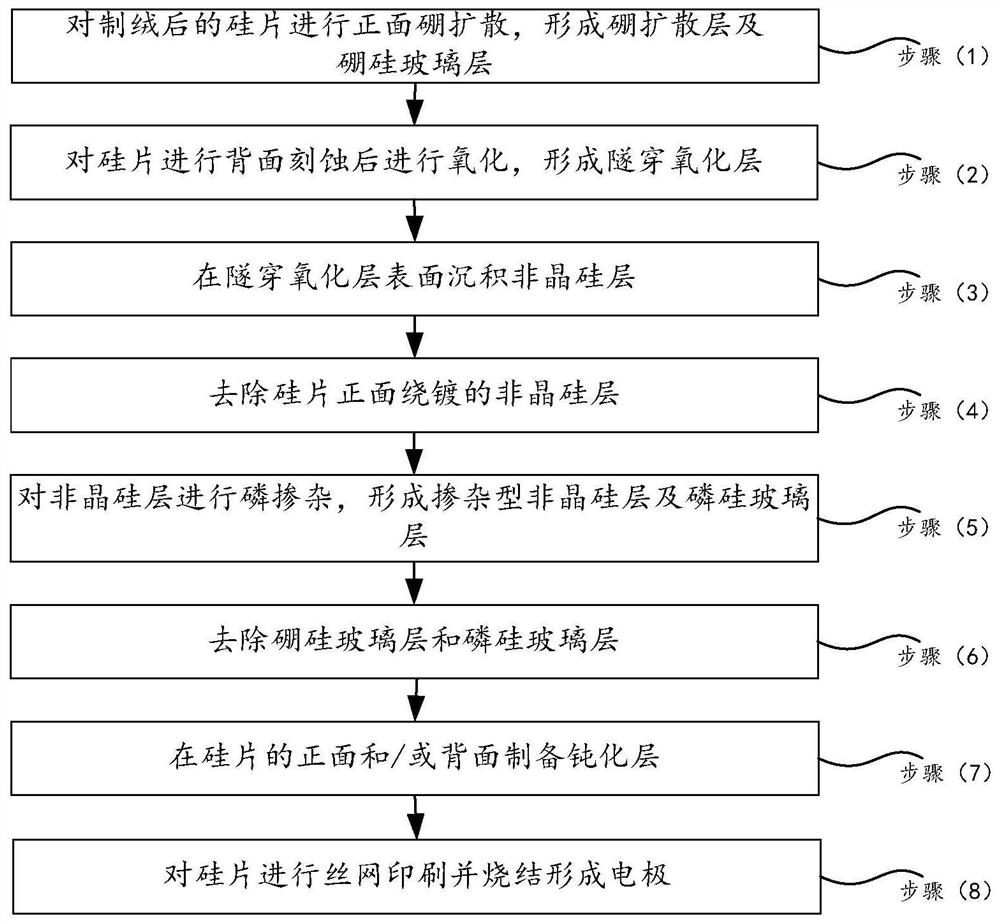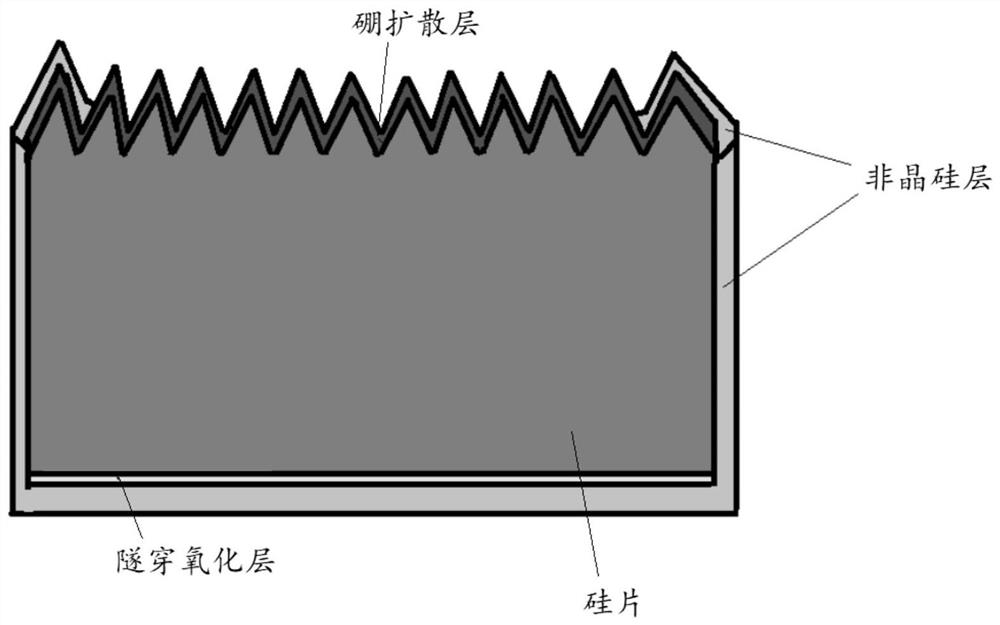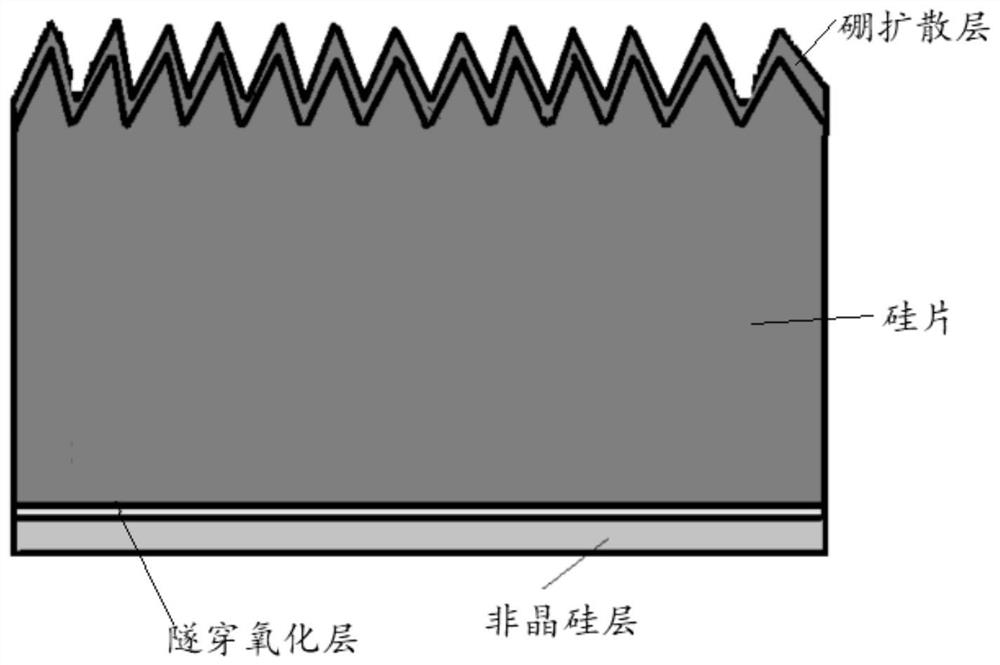Solar cell and preparation method thereof
A solar cell and electrode technology, applied in circuits, photovoltaic power generation, electrical components, etc., can solve problems such as damage to the borosilicate glass layer and overetching of silicon wafers
- Summary
- Abstract
- Description
- Claims
- Application Information
AI Technical Summary
Problems solved by technology
Method used
Image
Examples
preparation example Construction
[0035] figure 1 A flow chart of a method for preparing a solar cell provided in an embodiment of the present application, such as figure 1 As shown, the application provides a solar cell preparation method, comprising the following steps:
[0036] Step (1): performing boron diffusion treatment on the front side of the textured silicon wafer to form a boron diffusion layer and a borosilicate glass (BSG) layer;
[0037] Step (2): performing back etching on the silicon wafer and then oxidizing to form a tunnel oxide layer;
[0038] Step (3): Depositing an amorphous silicon layer on the surface of the tunnel oxide layer;
[0039] Step (4): removing the amorphous silicon layer coated on the front side of the silicon wafer;
[0040] Step (5): Doping the amorphous silicon layer with phosphorus to form a doped amorphous silicon layer and a phosphosilicate glass layer (PSG), and the doped amorphous silicon layer and the tunnel oxide layer form a TopCon structure;
[0041] Step (6) ...
Embodiment 1
[0067] Step (0): Texturing the front and back of the N-type crystalline silicon wafer;
[0068] Step (1): performing boron diffusion treatment on the front side of the silicon wafer to form a boron diffusion layer and a borosilicate glass (BSG) layer. At this time, the boron diffusion process will activate the doped boron atoms, making the silicon wafer change from microcrystalline phase to polycrystalline silicon phase.
[0069] Step (2): After etching the back side of the silicon wafer, it is oxidized by a low-pressure chemical vapor deposition method to form a tunnel oxide layer. Specifically, the raw material of the tunneling oxide layer is silicon dioxide, and the thickness of the tunneling oxide layer is 2 nm.
[0070] Step (3): Depositing an amorphous silicon layer on the surface of the tunnel oxide layer, the deposition temperature of the amorphous silicon is 550° C., and the thickness of the amorphous silicon layer is 150 nm;
[0071] Step (4): Clean the silicon waf...
Embodiment 2
[0077] Step (0): Texturing the front and back of the N-type crystalline silicon wafer;
[0078] Step (1): performing boron diffusion treatment on the front side of the silicon wafer to form a boron diffusion layer and a borosilicate glass (BSG) layer. At this time, the boron diffusion process will activate the doped boron atoms, making the silicon wafer change from microcrystalline phase to polycrystalline silicon phase.
[0079] Step (2): After etching the back side of the silicon wafer, it is oxidized by a low-pressure chemical vapor deposition method to form a tunnel oxide layer. Specifically, the raw material of the tunneling oxide layer is silicon dioxide, and the thickness of the tunneling oxide layer is 1 nm.
[0080] Step (3): Depositing an amorphous silicon layer on the surface of the tunnel oxide layer, the deposition temperature of the amorphous silicon is 560° C., and the thickness of the amorphous silicon layer is 120 nm;
[0081] Step (4): Use the prepared mixe...
PUM
 Login to View More
Login to View More Abstract
Description
Claims
Application Information
 Login to View More
Login to View More - R&D
- Intellectual Property
- Life Sciences
- Materials
- Tech Scout
- Unparalleled Data Quality
- Higher Quality Content
- 60% Fewer Hallucinations
Browse by: Latest US Patents, China's latest patents, Technical Efficacy Thesaurus, Application Domain, Technology Topic, Popular Technical Reports.
© 2025 PatSnap. All rights reserved.Legal|Privacy policy|Modern Slavery Act Transparency Statement|Sitemap|About US| Contact US: help@patsnap.com



